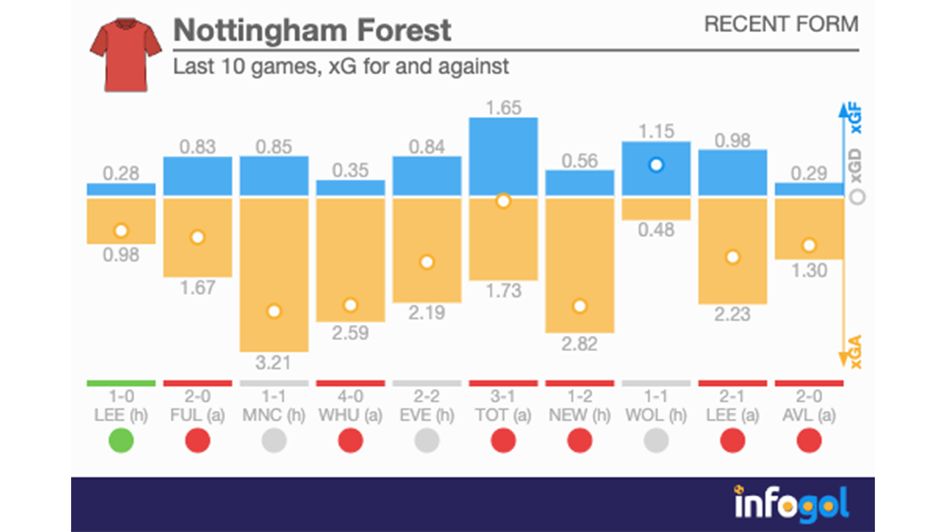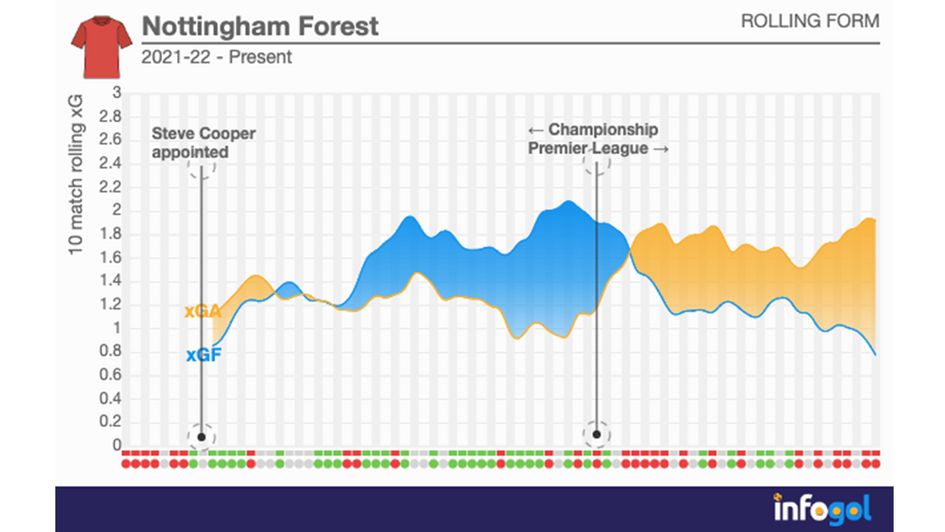There’s something about facing Aston Villa that produces eureka moments for Steve Cooper.
- Published before 2-0 defeat to Manchester United
It was their first meeting at the City Ground back in October, just three days after Nottingham Forest ended speculation by handing Cooper a new contract, when they abandoned the expressive possession style that had served them so well in the Championship (but led to some alarming defeats in the Premier League).
Instead, favouring a defensive system that kept men behind the ball and waited for chances to counter-attack.
Having conceded 16 goals in the previous four matches their 1-1 draw that day saw an obvious improvement - if not the result Forest had wanted against a Villa team struggling under Steven Gerrard.
But beyond the score line, Cooper and the Forest supporters were quietly confident he had struck on an idea that would turn the club’s fortunes around, while the owner, Evangelos Marinakis, felt vindicated for his vote of confidence.
Six months later and the story is repeating itself. Forest played Villa on Saturday shortly after a vote of confidence (albeit a less convincing one this time) and Cooper used the opportunity to trial a new system and a second go at a reboot.
Again, the result was not quite what he had in mind. But again, there was enough in the performance to suggest Forest might not be dead and buried just yet.
16th: Nottingham Forest - 26 points 🌳
— Sporting Life Football & Infogol (@InfogolApp) March 31, 2023
▪️ 20/26 - no other team in the survival fight has gained more home points
▪️ Issues facing Steve Cooper's side#NFFC | @nottm_forest | @Forest_Review pic.twitter.com/7nlG4x1yD3
Forest’s tactical timeline so far
The story of Forest’s up-and-down campaign is worth understanding before we get onto what can be done to avoid relegation over the final nine matches. A ridiculous squad overhaul in the summer badly affected Cooper’s ability to hit the ground running in August although his tactical plans were overly ambitious to say the least, which is why his move to a simpler style of reactive football was a welcome act of humility.
After the Villa draw, Forest won 18 points from the next 12 matches, the high point being a 1-0 victory over Liverpool at the City Ground, where Forest have won 21 of their 27 points this season.
Tellingly, since the October tactical switch their highest possession share in matches they have won is 39%, with 25% held against Liverpool and just 30% against Leeds United.
But since early February the tide began to turn, quite possibly because opponents began to work out the weaknesses in Cooper’s system – and stopped allowing Forest to sit back.

Across their last nine winless matches Forest have held the majority of possession on three occasions (against Fulham, West Ham, and Everton) and have recorded a higher xG than their opponent just once, compared with five times in the preceding 10.
We have seen opponents adapt their systems to exploit Cooper’s narrow 4-3-2-1, too. Leeds United and Newcastle United, for example, pummelled Forest down the flanks, where they are lightest, and moved quickly in the transition to take advantage of the large distances between Forest’s defensive line and front three.
As time has gone on, Forest have looked too disconnected from back to front and have lacked control in the wide areas – which is exactly what Cooper has sought to address with the second big Villa-debuted tactical change of the campaign.
New 3-4-2-1 could yield wins in tough run-in
For the first time since a 3-2 defeat to Fulham in September, Forest lined up with a back three at Villa Park, tweaking the 3-4-1-2 used in their promotion-winning season of 2021/22 to a 3-4-2-1 that gave a little extra defensive solidity against a Premier League midfield.
The bigger difference compared to last season, though, was the continuation of a counter-attacking philosophy.

Forest stayed behind the ball as Danilo and Morgan Gibbs-White, the two tens, sat on top of Douglas Luiz and John McGinn and stopped Villa from getting any kind of rhythm.
Meanwhile Neco Williams and Harry Toffolo – woefully exposed the week before at Leeds – were far more comfortable higher up the pitch and with an extra centre-back supporting them behind.
Things were going well – right up until Jonjoe Shelvey made a dreadful error to gift Bertrand Traore an opening goal, and from there Villa, on such good form, were able to hold out for the win.
Cooper is not blameless in this, given that a two-man central midfield (albeit one that morphs into a box-shaped four) was never likely to be a good fit for Shelvey, and after his mistake it is likely Remo Freuler or Orel Mangala will be rotated back into the side.
It should fix things centrally and could yield the three or four wins required to stay up, although Forest’s difficult run-in suggests Cooper’s new idea might have come a little too late.

Considering 78% of their points, and all but one of their wins, have come at home it is worrying that Forest face Manchester United, Brighton, Southampton, and Arsenal in their final four in Nottingham. Another shock result like the Liverpool win in October is surely needed.
That might seem an ominous note on which to leave things. But analysis of Forest’s season, where it has gone wrong, and how it might end in relegation should not automatically be framed through the usual lens of mismanagement and failure.
Even setting aside the absurd turnover in playing staff (and sporting directors), Forest surpassed all expectations in getting promoted and, judging by the quality of their squad, going down rock bottom on 20-25 points would be about par.
In other words, Cooper has dramatically overachieved to take Forest to this level and continues to overachieve keeping them competitive in the fight against the drop. His latest tactical switch could, with a bit of luck, lead to another surge up the table.
Yet it is no great catastrophe, and no failure, if it does not.










